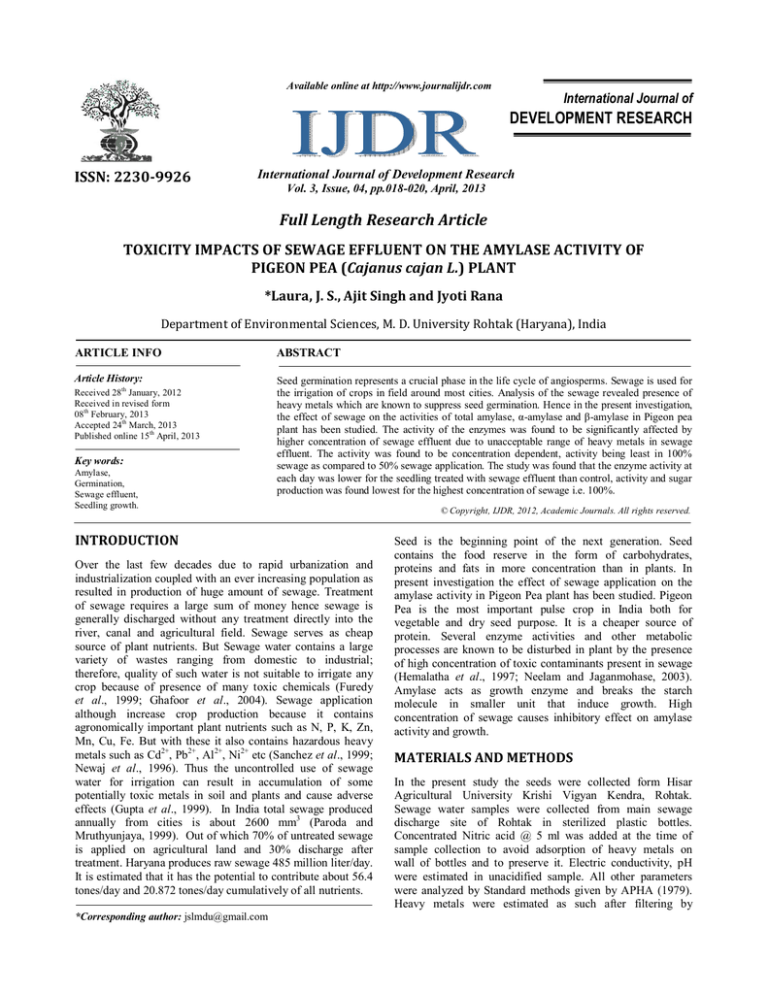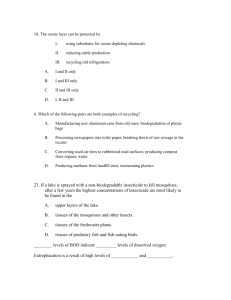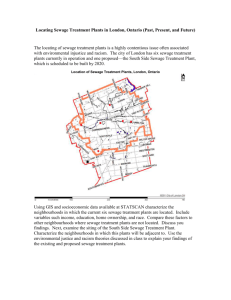
Available online at http://www.journalijdr.com
International Journal of
DEVELOPMENT RESEARCH
ISSN: 2230-9926
International Journal of Development Research
Vol. 3, Issue, 04, pp.018-020, April, 2013
Full Length Research Article
TOXICITY IMPACTS OF SEWAGE EFFLUENT ON THE AMYLASE ACTIVITY OF
PIGEON PEA (Cajanus cajan L.) PLANT
*Laura, J. S., Ajit Singh and Jyoti Rana
Department of Environmental Sciences, M. D. University Rohtak (Haryana), India
ARTICLE INFO
ABSTRACT
Article History:
Seed germination represents a crucial phase in the life cycle of angiosperms. Sewage is used for
the irrigation of crops in field around most cities. Analysis of the sewage revealed presence of
heavy metals which are known to suppress seed germination. Hence in the present investigation,
the effect of sewage on the activities of total amylase, α-amylase and β-amylase in Pigeon pea
plant has been studied. The activity of the enzymes was found to be significantly affected by
higher concentration of sewage effluent due to unacceptable range of heavy metals in sewage
effluent. The activity was found to be concentration dependent, activity being least in 100%
sewage as compared to 50% sewage application. The study was found that the enzyme activity at
each day was lower for the seedling treated with sewage effluent than control, activity and sugar
production was found lowest for the highest concentration of sewage i.e. 100%.
Received 28th January, 2012
Received in revised form
08th February, 2013
Accepted 24th March, 2013
Published online 15th April, 2013
Key words:
Amylase,
Germination,
Sewage effluent,
Seedling growth.
INTRODUCTION
Over the last few decades due to rapid urbanization and
industrialization coupled with an ever increasing population as
resulted in production of huge amount of sewage. Treatment
of sewage requires a large sum of money hence sewage is
generally discharged without any treatment directly into the
river, canal and agricultural field. Sewage serves as cheap
source of plant nutrients. But Sewage water contains a large
variety of wastes ranging from domestic to industrial;
therefore, quality of such water is not suitable to irrigate any
crop because of presence of many toxic chemicals (Furedy
et al., 1999; Ghafoor et al., 2004). Sewage application
although increase crop production because it contains
agronomically important plant nutrients such as N, P, K, Zn,
Mn, Cu, Fe. But with these it also contains hazardous heavy
metals such as Cd2+, Pb2+, Al2+, Ni2+ etc (Sanchez et al., 1999;
Newaj et al., 1996). Thus the uncontrolled use of sewage
water for irrigation can result in accumulation of some
potentially toxic metals in soil and plants and cause adverse
effects (Gupta et al., 1999). In India total sewage produced
annually from cities is about 2600 mm3 (Paroda and
Mruthyunjaya, 1999). Out of which 70% of untreated sewage
is applied on agricultural land and 30% discharge after
treatment. Haryana produces raw sewage 485 million liter/day.
It is estimated that it has the potential to contribute about 56.4
tones/day and 20.872 tones/day cumulatively of all nutrients.
*Corresponding author: jslmdu@gmail.com
© Copyright, IJDR, 2012, Academic Journals. All rights reserved.
Seed is the beginning point of the next generation. Seed
contains the food reserve in the form of carbohydrates,
proteins and fats in more concentration than in plants. In
present investigation the effect of sewage application on the
amylase activity in Pigeon Pea plant has been studied. Pigeon
Pea is the most important pulse crop in India both for
vegetable and dry seed purpose. It is a cheaper source of
protein. Several enzyme activities and other metabolic
processes are known to be disturbed in plant by the presence
of high concentration of toxic contaminants present in sewage
(Hemalatha et al., 1997; Neelam and Jaganmohase, 2003).
Amylase acts as growth enzyme and breaks the starch
molecule in smaller unit that induce growth. High
concentration of sewage causes inhibitory effect on amylase
activity and growth.
MATERIALS AND METHODS
In the present study the seeds were collected form Hisar
Agricultural University Krishi Vigyan Kendra, Rohtak.
Sewage water samples were collected from main sewage
discharge site of Rohtak in sterilized plastic bottles.
Concentrated Nitric acid @ 5 ml was added at the time of
sample collection to avoid adsorption of heavy metals on
wall of bottles and to preserve it. Electric conductivity, pH
were estimated in unacidified sample. All other parameters
were analyzed by Standard methods given by APHA (1979).
Heavy metals were estimated as such after filtering by
019
International Journal of Development Research, Vol. 3, Issue, 4, pp.018-020, April, 2013
digestion 100 ml of sample with diacid digestion and then
determined by AAS.
Amylolytic Activity
Different concentration of sewage effluent was taken to assess
the amylolytic activity. Amylolytic activity was assessed in
control, 50% sewage and 100% sewage in petriplates. The
extraction and assay procedure used for this enzyme was
described by Swain and Dekker (1996). Germinating seeds
were extracted in 0.02 M tris-HCl (pH 7.4) containing 1mM
CaCl2 and 5mM β-mercaptoethanol, the cell free extract was
dialysed at 4°C against extraction buffer for 4 hrs. Total
amylase activity was assayed after adding 19mM CaCl2 to the
dialyzed extract to bring the total concentration of Ca2+ ion to
20mM. For determining individual activities of α and β
amylase, the dialyzed extract was subjected to different
pretreatment in order to selectively inactivate one of these
enzymes. Activity of α amylase was determined after
rendering β amylase inactive by complete removal of face preincubating the dialyzed extract containing 20mM CaCl2 with
7.5 mM p-hydroxymercuric benzoate at 20°C for 20 min. For
selectively assaying β amylase activity the dialysed extract
which contained only 1mM CaCl2, was pre-incubated with
10mM EDTA at 20°C for 20 min. Under these conditions α
amylase was rendered non-functional due to its absolute
requirement for Ca2+ ions.
RESULT AND DISCUSSION
heavy metals present in the solution (Fendri et al., 2012). The
activity was found to be highest between days 6-8 (Fig 1).
Amylase activity was highest in control unit due to non
availability of heavy metals. Same trend was found in the
activity of α amylase and β amylase as shown in (Fig 2 and 3).
On day 2-4 activity was found to be low and then after 4 days
there was a steep rise in activity. The α-amylase activity was
38% and 14% of control on day 2 for 50% and 100% sewage
treatment respectively and on day 8 it was 17% and 13% of
control for α amylase and β amylase respectively (Fig 2). The
β-amylase activity was also diminished in sewage treatment as
compare to control as on day 8 of imbibition i.e. 60% and 37%
for 50% and 100% treatment respectively (Fig 3). The study
showed that the amylolytic activity is dose dependent. The
enzyme activity at each day was lower for the seedling treated
with sewage effluent; activity was lowest for the highest
concentration of the sewage i.e. 100% and highest for the
control treatment. Sewage water along with nutrients
contained heavy metals in varying concentration. So at 50%
sewage treatment inhibitory effect was less than the 100%
treatment, it may be due to the dilution of toxic substances
including heavy metals at 50% treatment, which may interfere
in the metabolism of seedling. While at 100% sewage effluent
treatment inhibitory effect was more pronounced at the load of
toxic substances increase which in term diminished levels of
starch also interferes with starch biosynthesis and hydrolysis.
Same observations were also documented by Fendri et al.
(2012).
The physicochemical characteristics of sewage water
presented in Table 1 indicate that pH; EC and BOD were
within permissible limit. Table 1 also indicates the heavy
metal concentrations present in sewage. Except Cadmium and
Lead all heavy metals were found within permissible range
when compared with irrigation water standards given by
Indian Standards.
Table 1. Average physico-chemical characteristics of
sewage effluent
Parameters
pH
Conductance
BOD
Cadmium
Chromium
Nickel
Lead
Copper
Zink
(ds/m)
(mg/l)
(mg/l)
(mg/l)
(mg/l)
(mg/l)
(mg/l)
(mg/l)
Sewage Effluent
7.4
1.7
250
0.065
0.183
0.195
0.595
0.0674
0.238
Fig. 1. Total Amylase activity in Pigeon pea under sewage
treatment (maltose/seed/day)
Amylolytic Activity
It was found that different concentration of sewage effluent
cause a very interesting effect on the activity of total amylase,
α amylase and β amylase. Enzyme activity showes very little
increase in the log phase of imbibitions or day 2-4. After day 4
the amylase activity showed a steep rise in the activity of
amylase. Total amylase activity of seedling under two
gradients of sewage effluent showed constant rise from day
4-8 after imbibitions (Fig 1). In 50% sewage treatment the
total amylase activity was found to be more than 100%
treatment from day 2-8 after imbibitions i.e. on day 2 it was
found to be 83% and 46% of control respectively and on day 8
it was 87% and 51% of control respectively due dilution of
Fig. 2. α – Amylase activity in Pigeon pea under sewage treatment
(maltose/seed/day)
020
International Journal of Development Research, Vol. 3, Issue, 4, pp.018-020, April, 2013
Fig. 3. β – Amylase activity in Pigeon pea under sewage treatment
(maltose/seed/day)
CONCLUSION
The present investigation showed that the sewage
concentration inhibit the enzyme activity. It was conclude
that the amylase activity in present study is dose dependent.
The amylolytic activity was found highest in control treatment
and lowest in the 100% of treatment. Sewage tends to hasten
the appearance of α-amylase during initial stage but its activity
was considerably diminished as the germination proceeds.
Activity of β-amylase was also suppressed by the high sewage
concentration particularly during early stag. After day 4 βamylase activity had, just begun to increase in seeds. The
results showed that the activity increase as the time of
imbibition increase and diminished with increased sewage
concentration.
REFERENCES
A.P.H.A. 1979. Standards methods for the examination of
water and waste water. 14th Ed. American Public Health
Association. New York.
Fendri, I., Ben Saad, R., Khemakhem, B., Ben Halima,
N., Gdoura, R. and Abdelkafi, S. 2012. Effect of treated
and untreated domestic wastewater on seed germination,
seedling growth and amylase and lipase activities
in Avena sativa L. J Sci Food Agric. doi: 10.1002/jsfa.
5923.
Furedy, C., Maclaren, V. and Whitney, J. 1999. Reuse of
waste for food production in Asian Cities: Health and
Economic Perspectives. In: Koc, M., Macrae, L.J.A.
Mougeot and J. Welsh (eds.), For Hunger-proof Cities,
Ottawa, pp. 136-144.
Ghafoor, A., Qadir, M., Sadiq, M., Murtaza, G. and Brar, M.S.
2004. Lead, Copper, Zinc and Iron Contaminations in
Soils and Vegetables Irrigated with City Effluent on
Urban Agricultural Lands. J Indian Society of Soil Sci.,
52: 114–7.
Gupta, M., Tripathi, R.D., Rai, U.N. and Haq, W. (1999).
Physiol Mol Biol Plants., 45: 173-180.
He, Jun-yu, Ren, Yan-fang, Zhu, Cheng and Jiang De-an.
2008. Effects of Cadmium Stress on Seed Germination,
Seedling Growth and Seed Amylase Activities in Rice
(Oryza sativa). Rice Science, 15(4): 319-325.
Hemalatha, S., Anburoy, A. and Francis, K. 1997. Effect of
heavy metals on certain biochemical constituents and
nitrate reductase activity in Oryza sativa seed. J Environ.
Biol., 18(3): 313-319.
Neelam, P. and Jaganmohase, K. 2003. Differential effect of
Cd and Hg on growth and metabolism of S. melongena
seedlings. J Environ. Biol., 24(4): 453-460.
Newaj, R., Deb Roy, R., Bisaria, A.K. and Singh, B. 1996.
Production potential and economics of perennial pigeon
pea based alley cropping systems. Range Mgmt. &
Agroforestry., 17(1): 69-74.
Paroda, R.S. and Mruthyunjaya 1999. NARS in the Asia
Pacific Region: A perspective, Asia Pacific Association of
Agricultural Research Institutions. FAO, RAPA,
Bangkok.
Sanchez, P.G., Fernandez, L.P., Trejo, L.T., Elcantar, G.J. and
Cruz, J.D. 1999. Heavy metal accumulation in beans and
its impact on growth and yield under soil less culture.
International symposium on growing media and
hydroponics. Acta Hortic., 481: 617-623.
Swain, R.R. and Dekker, E.E.C. (1996). Seed germination
studies II. Pathway of starch degradation in germinating
pea seedlings. Biochem. Biopys. Acta., 122: 87-100.
*******






